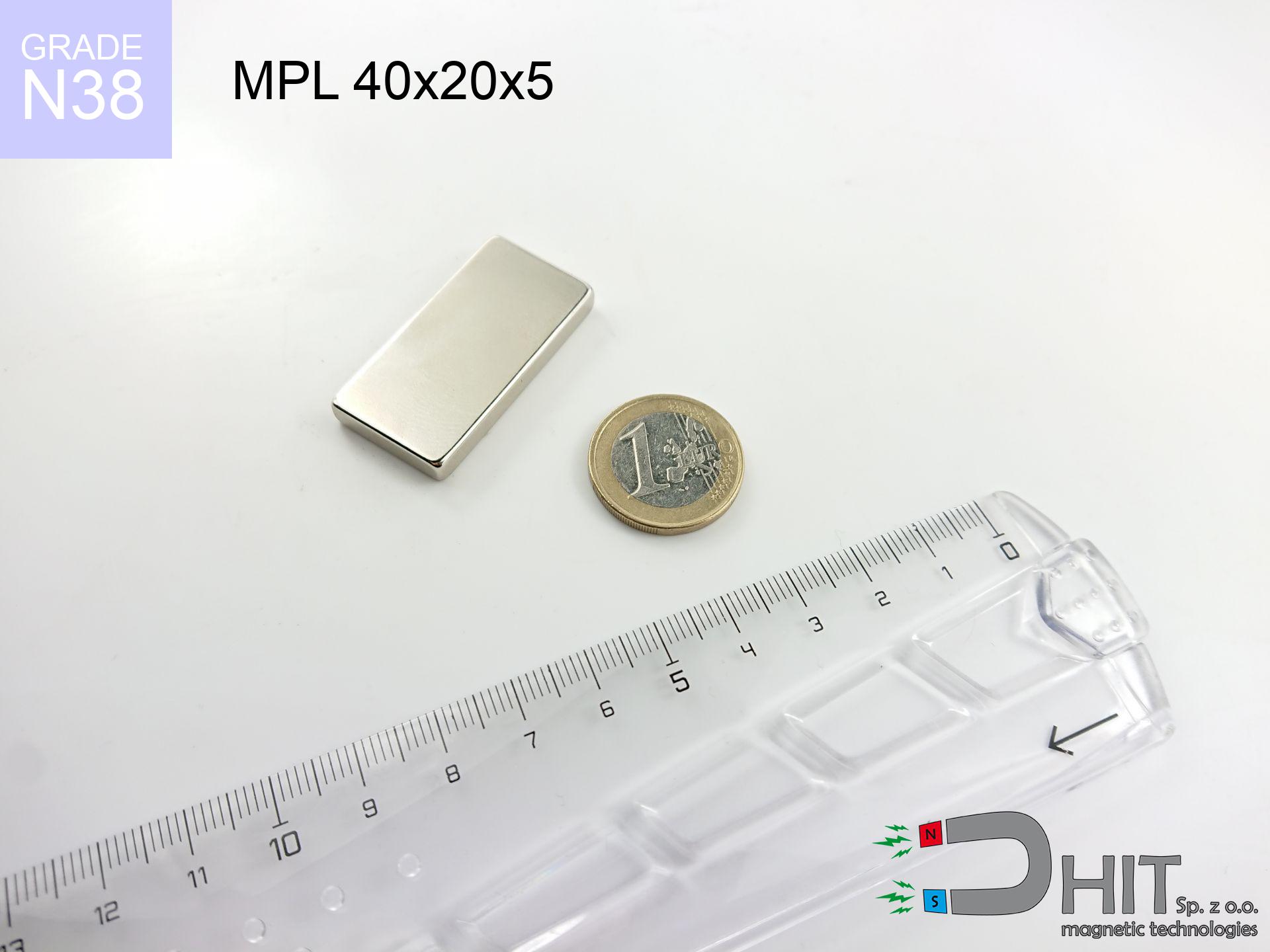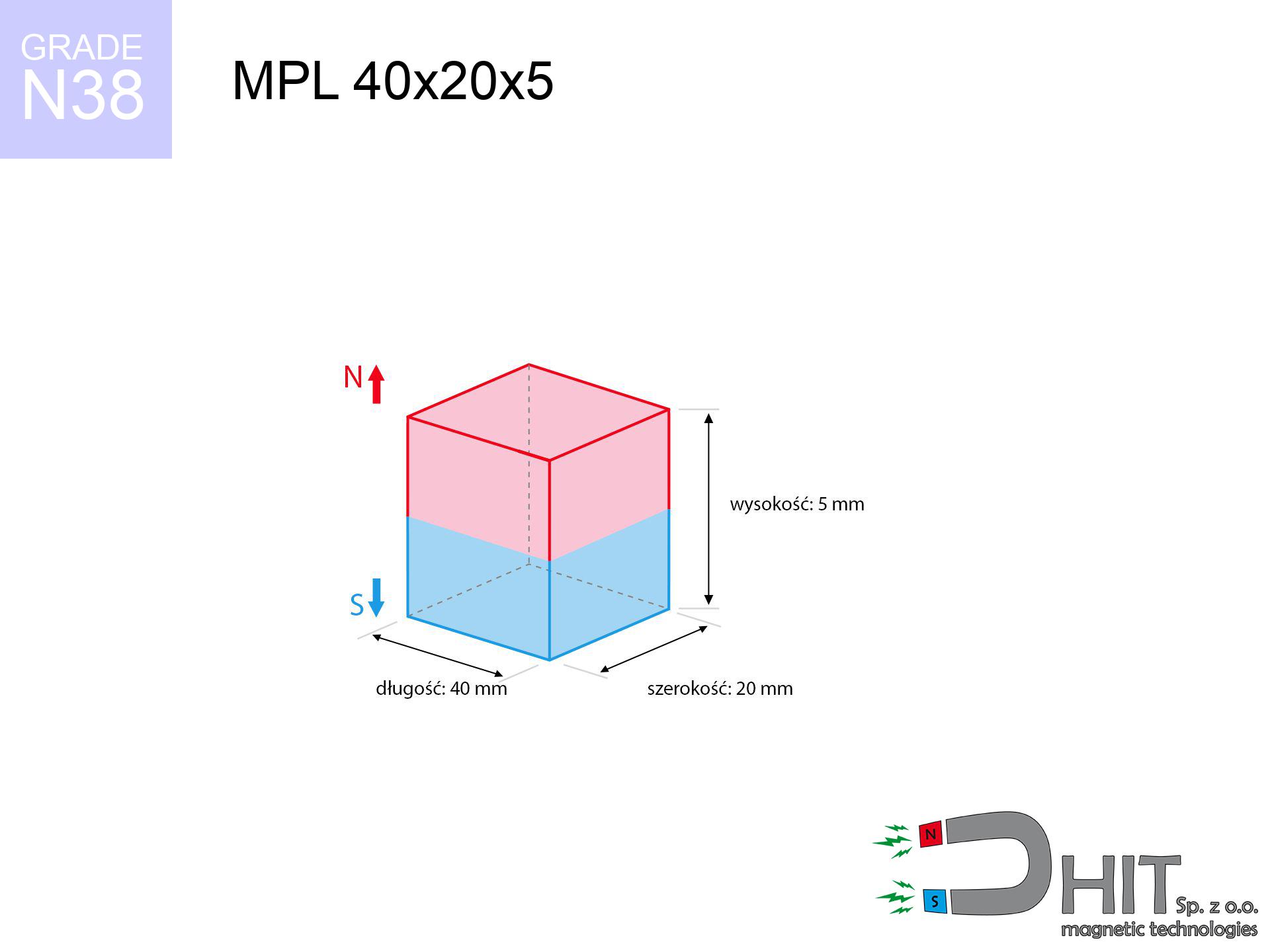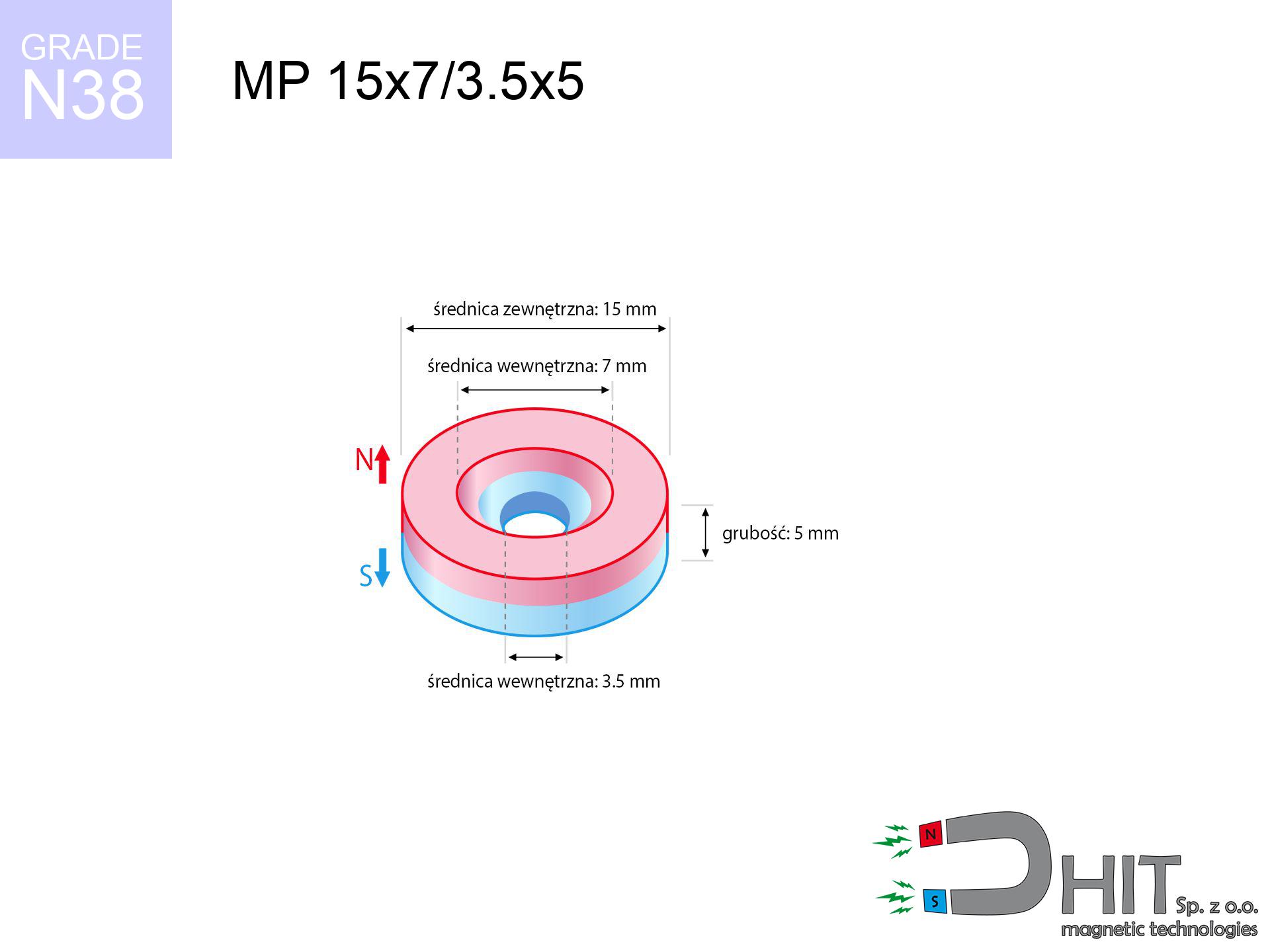MPL 40x20x5 / N38 - neodymium magnet
lamellar magnet
catalog number 020160
GTIN: 5906301811664
length
40
mm [±0,1 mm]
width
20
mm [±0,1 mm]
height
5
mm [±0,1 mm]
magnetizing direction
↑ axial
capacity ~
11.17 kg / 109.54 N
magnetic induction ~
205.27 mT / 2,053 Gs
max. temperature
≤ 80
°C
catalog number 020160
GTIN: 5906301811664
length
40 mm [±0,1 mm]
width
20 mm [±0,1 mm]
height
5 mm [±0,1 mm]
magnetizing direction
↑ axial
capacity ~
11.17 kg / 109.54 N
magnetic induction ~
205.27 mT / 2,053 Gs
max. temperature
≤ 80 °C
14.93 ZŁ gross price (including VAT) / pcs +
12.14 ZŁ net price + 23% VAT / pcs
bulk discounts:
need more quantity?Don't know what to choose?
Give us a call tel: +48 888 99 98 98 or contact us through form on our website. You can check the strength and the shape of neodymium magnets in our magnetic calculator power calculator
Orders placed by 2:00 PM will be shipped on the same business day.
Specification: lamellar magnet 40x20x5 / N38 ↑ axial
Magnetic properties of the material N38
Physical properties of sintered neodymium magnets Nd2Fe14B
Due to their power, flat magnets are regularly used in products that require exceptional adhesion.
Most common temperature resistance of flat magnets is 80 °C, but depending on the dimensions, this value can increase.
Moreover, flat magnets often have special coatings applied to their surfaces, such as nickel, gold, or chrome, for enhancing their strength.
The magnet named MPL 40x20x5 / N38 and a lifting capacity of 11.17 kg which weighs only 30.00 grams, making it the perfect choice for projects needing a flat magnet.
Contact surface: Due to their flat shape, flat magnets ensure a greater contact surface with other components, which can be beneficial in applications requiring a stronger magnetic connection.
Technology applications: They are often used in different devices, such as sensors, stepper motors, or speakers, where the flat shape is necessary for their operation.
Mounting: The flat form's flat shape makes mounting, particularly when it is necessary to attach the magnet to another surface.
Design flexibility: The flat shape of the magnets allows creators a lot of flexibility in placing them in devices, which can be more difficult with magnets of other shapes.
Stability: In some applications, the flat base of the flat magnet can offer better stability, reducing the risk of shifting or rotating. It’s important to keep in mind that the optimal shape of the magnet is dependent on the specific project and requirements. In some cases, other shapes, like cylindrical or spherical, may be a better choice.
Magnets have two poles: north (N) and south (S), which interact with each other when they are different. Poles of the same kind, e.g. two north poles, repel each other.
Due to these properties, magnets are often used in magnetic technologies, e.g. motors, speakers, sensors, or magnetic locks. Neodymium magnets stand out with the greatest strength of attraction, making them ideal for applications requiring strong magnetic fields. Moreover, the strength of a magnet depends on its size and the materials used.
It’s worth noting that high temperatures can weaken the magnet's effect. Every magnetic material has its Curie point, meaning that once this temperature is exceeded, the magnet stops being magnetic. Additionally, strong magnets can interfere with the operation of devices, such as navigational instruments, magnetic stripe cards or medical equipment, like pacemakers. Therefore, it is important to avoid placing magnets near such devices.
Compilation of suggested goods
Advantages and disadvantages of neodymium magnets NdFeB.
Apart from immense strength, neodymium magnets have the following advantages:
- They do not lose strength over time. After about 10 years, their power decreases by only ~1% (theoretically),
- They protect against demagnetization caused by external magnetic sources extremely well,
- By applying a shiny coating of nickel, gold, or silver, the element gains an aesthetic appearance,
- They possess very high magnetic induction on the surface of the magnet,
- By using an appropriate combination of materials, they can achieve significant thermal resistance, allowing them to operate at temperatures up to 230°C and above...
- The ability for precise shaping or customization to specific needs – neodymium magnets can be produced in many variants of shapes and sizes, which amplifies their universality in usage.
- Wide application in the industry of new technologies – find application in computer drives, electric drive mechanisms, medical apparatus and other highly developed apparatuses.
Disadvantages of neodymium magnets:
- They are fragile when subjected to a strong impact. If the magnets are exposed to impacts, we recommend using magnets in a steel housing. The steel housing in the form of a holder protects the magnet from impacts and at the same time increases its overall strength,
- Magnets lose their strength due to exposure to high temperatures. In most cases, when the temperature exceeds 80°C, these magnets experience permanent loss in strength (although it is worth noting that this is dependent on the form and size of the magnet). To avoid this problem, we offer special magnets marked with the [AH] symbol, which exhibit high temperature resistance. They can operate even at temperatures as high as 230°C or more,
- Magnets exposed to a humid environment can corrode. Therefore, when using them outdoors, we recommend using waterproof magnets made of rubber, plastic, or other moisture-resistant materials,
- The use of a cover - a magnetic holder is recommended due to the limited production capabilities of creating threads or complex shapes in the magnet
- Possible danger associated with microscopic parts of magnets pose a threat, if swallowed, which becomes significant in the context of child safety. Furthermore, miniscule components of these magnets are able to complicate diagnosis in case of swallowing.
Handle Neodymium Magnets Carefully
Do not place neodymium magnets near a computer HDD, TV, and wallet.
Neodymium magnets generate strong magnetic fields that can destroy magnetic media such as floppy disks, video tapes, HDDs, credit cards, magnetic ID cards, cassette tapes, or other devices. They can also destroy devices like video players, televisions, CRT computer monitors. Remember not to place neodymium magnets close to these electronic devices.
Neodymium magnets can demagnetize at high temperatures.
Although magnets have shown to retain their effectiveness up to 80°C or 175°F, this temperature may vary depending on the type of material, shape, and intended use of the magnet.
Neodymium magnetic are noted for being fragile, which can cause them to become damaged.
Magnets made of neodymium are highly delicate, and by joining them in an uncontrolled manner, they will crumble. Neodymium magnets are made of metal and coated with a shiny nickel, but they are not as durable as steel. At the moment of collision between the magnets, sharp metal fragments can be dispersed in different directions.
Neodymium Magnets can attract to each other due to their immense internal force, causing the skin and other body parts to get pinched and resulting in significant swellings.
Neodymium magnets will jump and also contact together within a radius of several to almost 10 cm from each other.
Dust and powder from neodymium magnets are flammable.
Do not attempt to drill into neodymium magnets. Mechanical processing is also not recommended. Once crushed into fine powder or dust, this material becomes highly flammable.
Never bring neodymium magnets close to a phone and GPS.
Magnetic fields can interfere with compasses and magnetometers used in aviation and maritime navigation, as well as internal compasses of smartphones and GPS devices. There are neodymium magnets in every smartphone, for example, in the microphone and speakers.
People with pacemakers are advised to avoid neodymium magnets.
In the case of neodymium magnets, there is a strong magnetic field. As a result, it interferes with the operation of a heart pacemaker. Even if the magnetic field does not affect the device, it can damage its components or deactivate the entire device.
Neodymium magnets are among the strongest magnets on Earth. The astonishing force they generate between each other can surprise you.
Make sure to review all the information we have provided. This will help you avoid harm to your body and damage to the magnets.
Magnets should not be treated as toys. Therefore, it is not recommended for youngest children to have access to them.
Neodymium magnets are not toys. Be cautious and make sure no child plays with them. In the case of swallowing multiple magnets simultaneously, they can attract to each other through the intestinal walls. In the worst case scenario, this can lead to death.
The magnet is coated with nickel - be careful if you have an allergy.
Studies show a small percentage of people have allergies to certain metals, including nickel. An allergic reaction often manifests as skin redness and rash. If you have a nickel allergy, try wearing gloves or avoid direct contact with nickel-plated neodymium magnets.
In order to illustrate why neodymium magnets are so dangerous, see the article - How very dangerous are powerful neodymium magnets?.



![magnetic separator 25x150 [2xM8] / N52 magnetic separator 25x150 [2xM8] / N52](https://cdn3.dhit.pl/graphics/products/sm-25x150-2xm8-sux.jpg)


![magnetic separator 32x500 [2xM8] / N42 magnetic separator 32x500 [2xM8] / N42](https://cdn3.dhit.pl/graphics/products/sm-32x500-2xm8-jan.jpg)

